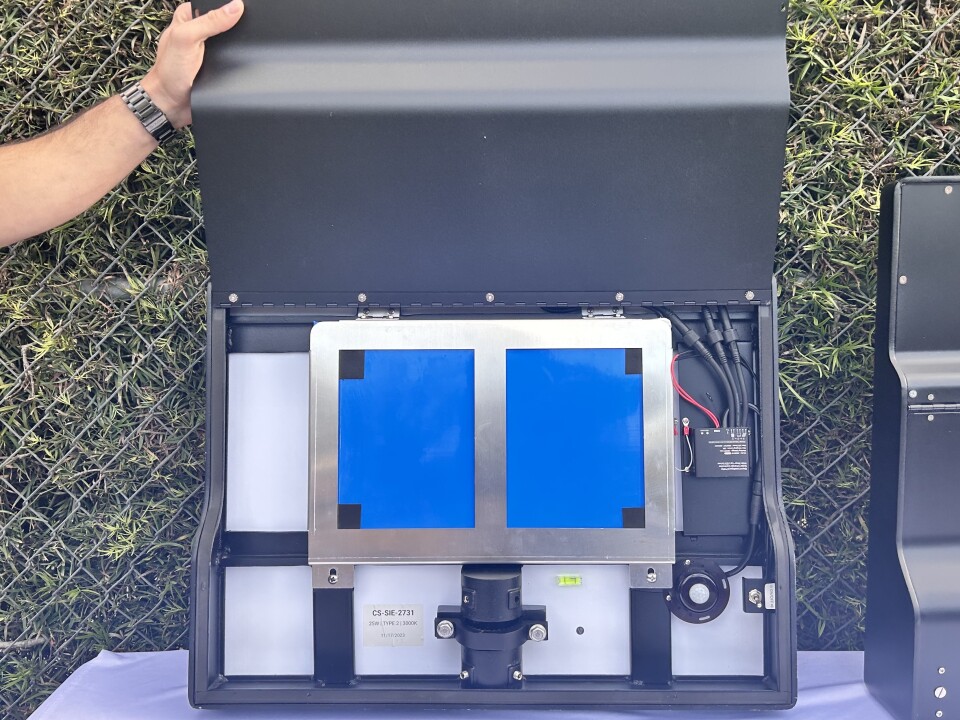Truth matters. Community matters. Your support makes both possible. LAist is one of the few places where news remains independent and free from political and corporate influence. Stand up for truth and for LAist. Make your year-end tax-deductible gift now.
Residents Are Fed Up With Copper Theft Shutting Off Street Lights. LA Turns To Solar As Antidote

Los Angeles is flipping the switch from wired to solar streetlights under a new pilot program. The city’s transition will swap out copper wiring in favor of the battery-enabled, all-in-one systems that go beyond savings on the power bill.
That's because traditional streetlights have been a popular target for copper thieves and vandals — costing the city of L.A. more than $20 million in repairs in the past year alone.
The pilot is kicking off with 104 solar streetlights across Van Nuys, but could expand to another 800 units in different neighborhoods. They’re part of the city’s efforts to get lights on quicker, and keep them on longer, Mayor Karen Bass said at a news conference Thursday.
How it can curb copper crimes
Thieves stealing copper wherever they can find it has been a growing concern in the city — with some thefts knocking out streetlights and endangering road safety. Because the solar lights do not have copper wire, they're a disappointing target for a thief. Bass said that's important because thefts have become so widespread.
There is a tradeoff. Miguel Sangalang, the director of the Bureau of Street Lighting, told LAist that the solar system is about 10 times more expensive than the ones the city uses now — between $3,000 to $5,000 each.
“However, the savings really comes from when we deploy people,” Sangalang said. “In the case of theft and vandalism, one streetlight only really takes us two deployments, so if we have to go back there twice, it already paid for themselves.”
Why start in Van Nuys?
The pilot started in Van Nuys because it's been one the areas hardest hit by copper wire crimes, he added.
Sangalang said that while someone can still dig into and damage the infrastructure of the lights, they’ll find out quickly there’s no copper wire to steal. The new lights were also engineered so they have little to no street value if stolen, and the Bureau of Street Lighting has added in some extra security measures as protection.
Kathy Schreiner, president of the Van Nuys Neighborhood Council, told LAist she gets regular complaints about streetlights at their monthly meetings, and it’s “miraculous” the new systems are starting in their neighborhood.
“It's a very important thing for our community, and we're really happy,” she said.
L.A. City Councilmember Imelda Padilla, who represents the area, said street lighting is integral to a neighborhood’s sense of community and safety.
“And through this program, we will be able to better illuminate public spaces, enhancing visibility during darker hours, delivering tangible improvements in quality of life issues,” Padilla said.
About the new solar streetlights
One of the new lights sits at the intersection of Sylvan Street and Cedros Avenue, right next to the Children's Community School.
Backers of the project say solar lights are brighter, and more resilient. They don’t rely solely on the power grid, so even if an earthquake takes out the city’s electrical system, the streetlights can sustain themselves.
And some of the parts were made right here in Los Angeles. Pieces of metal used in the lights are painted, poured, and assembled in the city by Grid Shift Solar Lighting, according to Ryan Lamb from the company's sales team.

The solar panel charges the battery in the light, the battery feeds into the LED, and the system is clamped onto the existing arm on the pole.
“Then you just turn it on, and basically it's self powered from there on out,” Lamb said.
What's next
The program is still considered a pilot because the city wants to prove that it works long term, Sangalang said.
“We'll be taking the next year to collect data, making sure that it operates in the parameters that we expect it to operate,” he said.

For example, they’ll be checking to make sure the solar lights can last at least two or three nights, even after a few days of cloudy skies or rain.
The city is already looking at expanding into other neighborhoods. They’re hoping to have a little more than 900 new solar streetlights installed across L.A. by next July. Sangalang said they’re still trying to figure out which areas would be best.
Some factors under consideration:
- There can’t be too many buildings or other obstructions since they rely on the sun.
- They’re also looking at ways to reduce drive time for street lighting crews.
- And yes, high-theft areas will get special consideration.
Sangalang says opportunities to "reduce repeat customers of copper wire theft,” will be prioritized. “Those are all factors for us to take into account,” he said.








